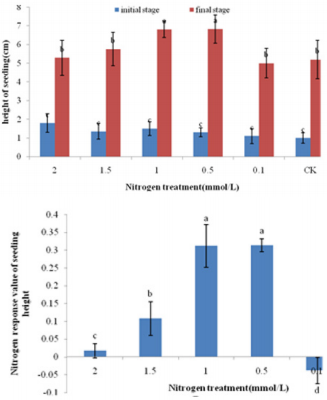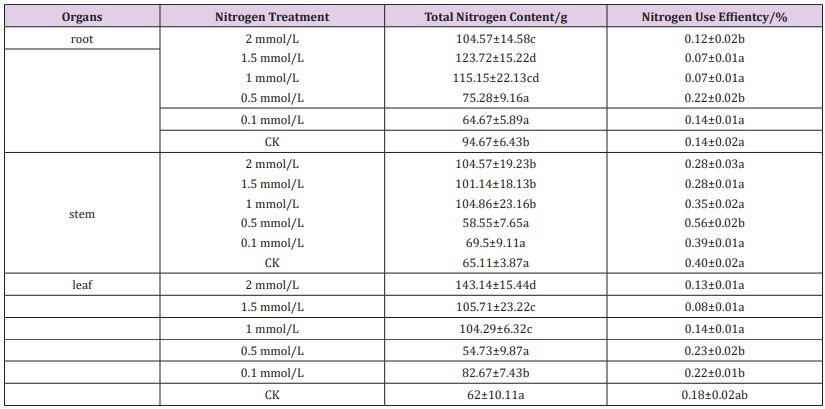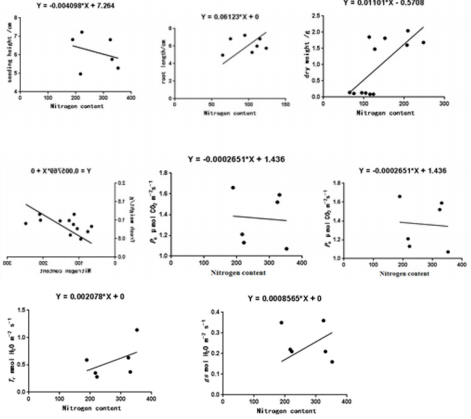Effects of Nitrogen Treatment on Growth Characteristics in Moso Seedling
Introduction
Nitrogen is the most important nutrient factor in plant growth
[1]. Application of nitrogen can affect plant nitrogen metabolism,
photosynthetic apparatus and energy distribution, respiratory
metabolism, etc. The ultimate manifestation of these physiological
metabolisms is the growth pattern of plants and biomass. However,
the concentration of nitrogen fertilization affects plant growth [2]
and the reasonable application of nitrogen fertilizer will promote
the growth of plants [3-6]. Therefore, the study on the effects of
nitrogen on the growth of different plants has attracted more and
more attention. Moso bamboo is an important economic bamboo
species in China, nutrient absorption laws in different developmental
stages [7] of moso bamboo has been studied in recent years [8-12].
The results show that when nitrogen supply is sufficient, bamboo
depends mainly on improving nutrient content to maintain life
activities. When nitrogen is poor, it adapts to environment changes
mainly by increasing nutrient resorption. However, these results
are based on data obtained from field trials, and different ages
plants have a greater impact on nitrogen uptake and transport [13].
There is no report on the demand for nitrogen fertilizer in bamboo
seedlings only Shao JF [14] studied the hydroponic system of
bamboo seedlings, it’s found that the application of nitrate nitrogen
is more suitable for bamboo seedlings growth.
Therefore, it is important to determine the nitrogen fertilizer concentration avoid the excess nitrogen addition for bamboo seedlings cultivation [15]. In this study, the photosynthetic efficiency and growth characteristics of moso bamboo seedling were determined, the effects of total nitrogen content and nitrogen absorption and translocation efficiency of moso bamboo seedling under different nitrogen treatments were analyzed and the optimum nitrogen fertilizer concentration for moso bamboo seedling cultivation was determined. It provide a theoretical support for moso bamboo seedling breeding technology.
Material and Method
Plant Culture and Experimental Treatment
Collect 500 new seeds of moso bamboo, peel off the seed coat, soak it in cold water for 48 hours, rinse the tap water and wash it, wash off the excess detergent, rinse it with water for 0.5-1h, then wash it with distilled water. Put it into a clean bench, soak it in 0.5 %-0.8 % formaldehyde for 4-6 h, sterilize the seeds evenly after shaking for several times, rinse it with sterile water 4 times after sterilization, put it on the water-impregnated filter paper, and put it in the dark and germinate at 25℃. After the seeds were germinated, they were sown in clean, moist quartz sand in March 27, 2017. After 15 days, the seedlings with the same growth were selected and transplanted to a 1/2 concentration Hoagland nutrient solution: 0.5 mmolL-1P was supplied with KH2PO4, 3 mmolL-1 was supplied with KNO3 and KH2PO4, 2.5 mmolL-1Ca was supplied with Ca(NO3)·2H2O,1.0 mmolL-1Mg was supplied with MgSO4, and the micronutrients were 46.26 μmolL-1Mg>1B(H3BO3),20.06μmolL-1 Fe(EDTA-Fe), 9.15μmolL-1Mn (MnCl2·4H2O),0.77 μmolL-1Zn (ZnSO4·7H2O),0.32μmolL-1Cu(CuSO4·5H2O) and 0.39μmolL-1Mo(H2MoO4.4H2O).NH4NO3 was added for different concentrations of N treatment. The treatment concentrations were 2 mmol/L, 1.5 mmol/L, 1 mmol/L, and 0.5 mmol/L, respectively. The control CK did not add NH4NO3. Each of the bamboo seedlings was treated with 20 plants, each plant was numbered, the nutrient solution was continuously ventilated by the same pump. The pH of all treated nutrient solutions was adjusted with a pH meter and 0.1 molL-1 NaOH or 0.1 molL-1 HCL to keep it at around 7.35, and the nutrient solution of different treatment concentrations were changed in two days.
To exclude the complex processing of sentence reading, the current study specifically compared Chinese and Japanese word processing in bilinguals while they decided whether two pairs of Chinese characters or Japanese kanjis were similar in meaning or not. Our purpose is to identify the networks involved in semantic processing of Chinese characters and Japanese kanjis, to test if words of both the languages use the same network without involving phonological processing. Furthermore, we want to quantify the differences of semantic processing in the two languages if there are any. This would indicate whether the two groups of bilinguals use the same strategy for semantic processing of logographic characters.
Determination of Seedling Height, Root Length, Internode Length, Biomass and Water Content
From April 10, 2017 (initial stage of treatment) to May 10 (end stage of treatment), each seedling was measured every 3 days, including seedling height, root length, first internode length, second internode length, and third internode length. The seedlings were treated with different nitrogen concentration, and fresh weight of the roots, stems and leaves was measured(W1), the leaves were gently wiped with a wet gauze, and the roots were washed with deionized water and then blotted with absorbent paper. After being killed (105℃, 30 minutes), it is dried to constant weight at 70℃, and the dry weight of roots, stems and leaves (W2) is measured. Water content = (W1-W2) / W1* 100%.
Determination of Photosynthesis Index
After the treatment, 3~5 pieces leaves with relatively uniform light were selected The net photosynthetic rate (Pn) and Maximum photochemical efficiency (Fv/Fm) of the leaves were determined by Li-COR6400 portable photosynthetic apparatus (Li-COR, USA) and ultra-portable chlorophyll fluorescence instrument Mini-PAM (WALZ, Germany) from 9:00 to 11:30. The experiment was controlled at room temperature of 25℃, light intensity of 800μmol·m-2·s-1, and reference chamber CO2 concentration of 380 mol·L-1. Three replicate plants were determined, and three leaves were selected per plant, and the results were averaged.
Determination and Calculation of Nitrogen-Related Index of Bamboo Seedlings After Nitrogen Treatment
a) Determination of total nitrogen content: After treatment, different concentrations of seedlings were collected, and the total nitrogen content of roots, stems and leaves was determined by H2SO4-H2O2 digestion method.
b) Nitrogen response value of seedling height = (end-stage seedling height after nitrogen treatment - end-stage seedling height of CK) / end-stage seedling height of CK
c) Nitrogen response value of seedling root length = (endstage root length after nitrogen treatment - end-stage root length of CK) / end-stage root length of CK d) Nitrogen use efficiency (%) = dry weight / total nitrogen content × 100%.
Statistical and Data Analyses
Use Excel 2007 and SPSS14.0 to perform statistical analysis, use one-way ANOVA and LSD for variance analysis and multiple comparisons (α = 0.05) and uselinear regression for correlation analysis. The data in the chart are mean value ± standard deviation.
Results
The Growth Characterics After Nitrogen Treatment in Moso Seedlings
As Figure 1 shown, From the initial stage to the end of the treatment, the seedling height and root length of bamboo were gradually increased. Studies have shown that in the initial stage of treatment, the difference in seedling height of bamboo seedling was not significant, and the final seedling height was significantly higher after treatment at 0.5 mmol/L and 1 mmol/L than other treatments. The seedling height in final stage increased by 193.89%, 402.30%, 354.67%, 437.91%, 739.58% and 451.85% with the treatment concentration from high to low, respectively. Among them, 0.1 mmol/L had the highest seedling height increase rate, and 2 mmol/L had the lowest seedling height increase rate after treatment. The calculation results of nitrogen response to seedling height showed that the nitrogen response of bamboo seedling after treatment at 0.5 mmol/L and 1 mmol/L was significantly higher than that of other treatments. As Figure 2 shown, at the beginning of the treatment, there was no significant difference in root length of bamboo seedlings with different nitrogen treatments.
Figure 1: Variation of height characters after nitrogen treatment in moso seedlings.
Note: Different small letters meant significant difference among different nitrogen treatment at 0.05 level. The same below.
The final root length with 0.5mmol/L treatment was significantly higher than other treatments. The root length in end stage increased by 47.27%, 50.42%, 92.43%, 82.62%, 90.91% and 13.47% with the treatment concentration from high to low. 0.1 mmol/L, 0.5 mmol/L and 1.0 mmol/L treatment root length had the highest seedling height increase rate. Nitrogen response of root length showed that the nitrogen response of root length with 1.5 mmol/L, 1.0 mmol/L and 0.5 mmol/L treatment was significantly higher than other treatments. Studies have shown that with the increase of nitrogen treatment, the growth of bamboo seedlings first increases and then decreases. The seedling height and root length of the bamboo seedlings with 0.5 mmol/L and 1 mmol/L treatment were higher. The growth of bamboo seedling was significantly inhibited after 2 mmol/L treatment. The internode elongation rate of bamboo seedling was counted from the initial stage to the end stage in Figure 3. After the 2mmol/L nitrogen treatment, the first internode length of the bamboo seedling was longer and the elongation rate was faster. The length between the second and third sections is shorter and the elongation speed tends to be gentle.
The other treatments were opposite to the 2 mmol/L treatment results. The growth of the first internode was shorter and the elongation rate was slower , but the growth was faster and longer during the second and third internodes.in 0.1 mmol/L, 0.5 mmol/L,1.0 mmol/L and 1.5 mmol/L treatment (Table 1).
Table 1: Biomass and water content after nitrogen treatment in moso seedlings.
Note: Different small letters in the same line meant significant difference among different nitrogen treatment at 0.05 level. The same below.
The total biomass, root, stem and leaf biomass of moso bamboo seedlings at the end of the stage are shown in Table 2. The total biomass and stem biomass of bamboo seedling after 1mmol/L treatment were the highest among all the treatment and the index of the total biomass were consistent to the stem biomass. When the treatment concentration continued to increase, the total biomass and stem biomass began to decrease, and the value was the lowest after 2 mmol/L treatment. The leaf biomass with difference treatment were not significant. Root biomass values with CK were significantly lower than other treatments. Root/shoot ratio was the highest after treatment with 2 mmol/L, and the control group was the lowest. The results showed that the total biomass, stem and root biomass of the bamboo seedlings were the highest after 1 mmol/L treatment, and root/shoot ratio was larger when the nitrogen treatment concentration was higher.
Changes in Photosynthesis of Moso Seedlings After Nitrogen Treatment
As Table 2 shown, the photosynthesis parameters of moso bamboo leaves with different treatments were significant. The net photosynthetic rate Pn were significantly higher at 1.5mmol/L, 1mmol/L and 0.5mmol/L than other treatments ,and the difference of these three treatments was not significant. The transpiration rate Tr and the stomatal conductance gs have trends with different treatment. The Tr value and gs value were significantly higher at 0.5 mmol/L and 1 mmol/L than other treatments. The Tr value and gs value at 2 mmol/L treatment were significantly lower than other treatments. The maximum photochemical efficiency (Fv /Fm) of PSII was the highest after 0.5 mmol/L and 1 mmol/L treatment , but the difference between different nitrogen treatments was not significant. The results showed that with the increase of nitrogen concentration, Pn, Tr, gs and Fv/Fm of bamboo seedlings increased first and then decreased, and the photosynthesis parameters were highest with 1 mmol/L and 0.5 mmol/L treatment.
The Absorption and Transportation Efficiency of
Nitrogen in Moso Seedlings
The nitrogen content and nitrogen use efficiency of different
tissues and organs of different treatments were significantly
different (Table 3). The total nitrogen content was higher in the
high-nitrogen treatment in roots, stems and leaves (2 mmol/L, 1.5
mmol/L, 1 mmol/L), lower in low-nitrogen treatment (0.5 mmol/L,
0.1 mmol/L, CK).While the root and stem use efficiency was
significantly higher at 0.5 mmol/L treatment than other treatments.
Under different treatments, the nitrogen use efficiency of roots and
leaves was lower than that of stems, and there was no obvious rule
between different treatments.
Discussion
In this study, low nitrogen promoted the growth of moso
bamboo seedling, but the root growth rate of bamboo seedling
decreased when the concentration of nitrogen treatment reached
1.5 mmol/L, and the increasing rate of seedling height decreased
at 2 mmol/L, which indicated that excessive nitrogen fertilizer
first inhibited root growth, and then inhibit the growth of the
whole plant if the nitrogen fertilizer continued increased [16].
High concentration (2 mmol/L, 1.5 mmol/L) nitrogen treatment
significantly inhibited the elongation between the second and
third internodes of the bamboo seedling and promoted the
elongation between the first internodes. On the contrary, low
concentration (1 mmol/L, 0.5 mmol/L, 0.1 mmol/L, CK) nitrogen
treatment promoted the elongation between the second and third
internodes. It indicated that it can absorb more nitrogen fertilizer
and synthesize more protein under the high nitrogen treatment of
the bamboo seedling in the early stage , With the prolongation of
treatment time, high nitrogen inhibits the division and growth of
plants, while low nitrogen concentration is suitable for the growth
of bamboo seedlings and promote its growth. Nitrogen application
can significantly improve the potential photosynthetic capacity
,respiratory metabolism, and ultimately affect the establishment of
plant growth morphology and biosynthesis of the bamboo seedling.
Regression analysis showed that the total nitrogen content of
bamboo seedling after treatment was significantly correlated with
root length, fresh weight, Fv
/Fm, Tr
and gs
. The values of Pn
, Tr
and
gs
increased with the increase of nitrogen concentration, because
nitrogen directly affects the nitrogen metabolism, photosynthetic
apparatus and energy distribution of plants, and the appropriate
amount of nitrogen increases the nitrogen uptake of respiratory
metabolism, which is beneficial to photosynthesis and carbohydrate
synthesis [17-19] regulating photorespiration-related indices [20-
21], while excessive nitrogen application inhibits photosynthesis of
moso bamboo seedlings and inhibits their growth (Figure 4). In this
study, the bsiomass of bamboo seedlings was dominated by stalks
because plants can induce the distribution of nutrients to larger
above-ground organs [12]. Ye Jing’s research on Dendrocalamopsis
oldhami (Munro)Keng and Bambusa textilis McClure showed that
the distribution rate of Dendrocalamopsis oldhami (Munro) Keng
stalk biomass was more than half [22], which was consistent with
the results of this study.
Figure 4: Linear regression between total nitrogen content and growth, photosynthetic characters in moso seedlings.
The high-concentration nitrogen treatment (2 mmol/L, 1.5 mmol/L) of the bamboo seedlings has a high root-shoot ratio and high total nitrogen content. However, the nitrogen utilization efficiency of bamboo shoots is higher at low concentration of nitrogen treatment (1 mmol/L, 0.5 mmol/L, 0.1 mmol/L).Because nitrogen is the largest of all mineral nutrients [23] that affects root morphology, growth and its distribution in the medium. Plants have the root system into the nutrient-rich area to maximize the use of limited nutrient resources [24]. As a result, the nitrogen uptake rate of the root system increases, and the root-shoot ratio increases. At the same time, correlation analysis showed that the total nitrogen content was significantly correlated with root growth, which also fully explained the sensitivity of roots to nitrogen utilization [25- 26]. However, it was found that nitrogen can be efficiently absorbed by high-nitrogen treatment (2 mmol/L, 1.5 mmol/L), but it cannot be used efficiently. The results of the effects of nitrogen were consistent to maize seedling growth, root morphology and nitrogen uptake and utilization efficiency [27].









No comments:
Post a Comment
Note: Only a member of this blog may post a comment.